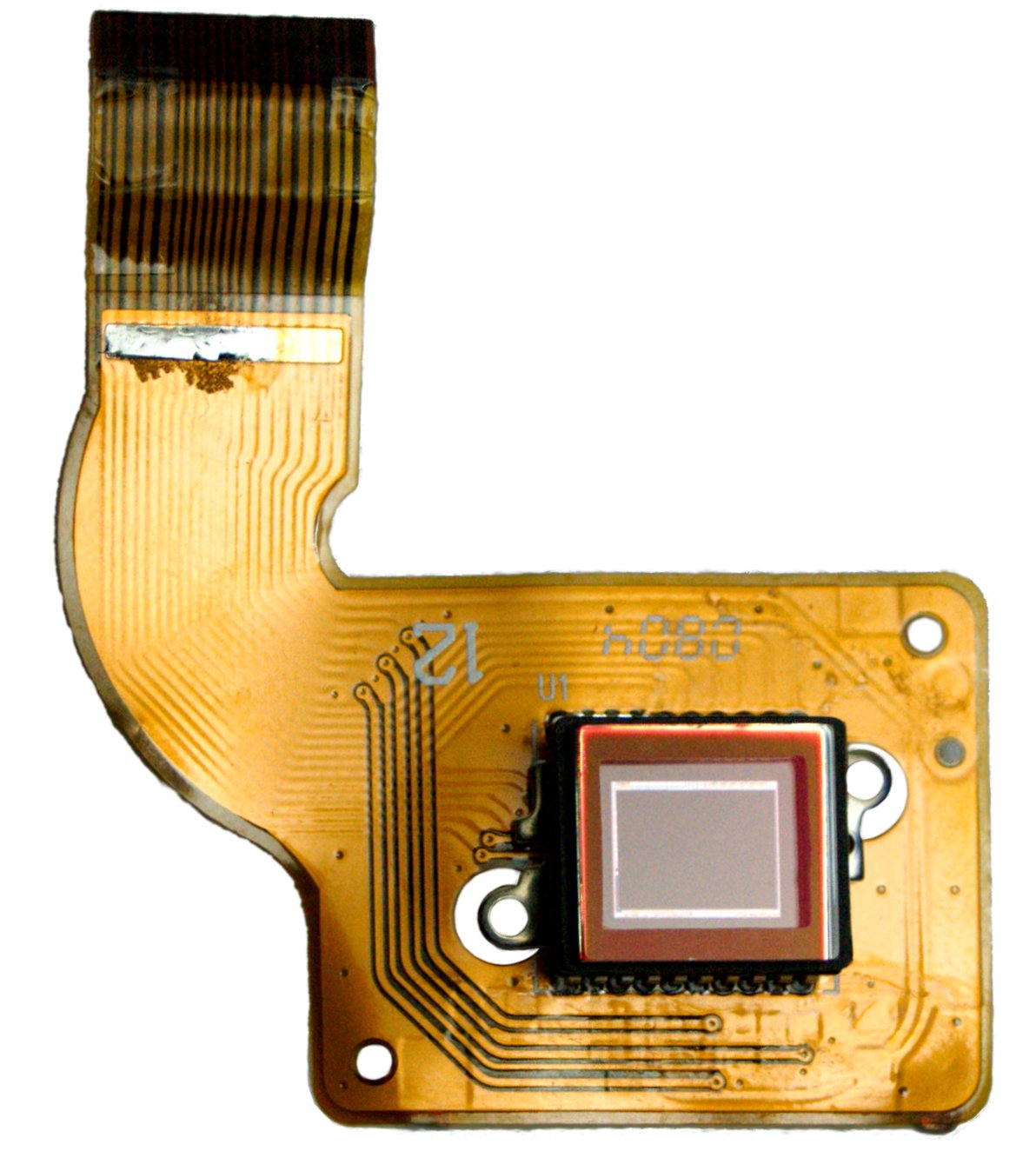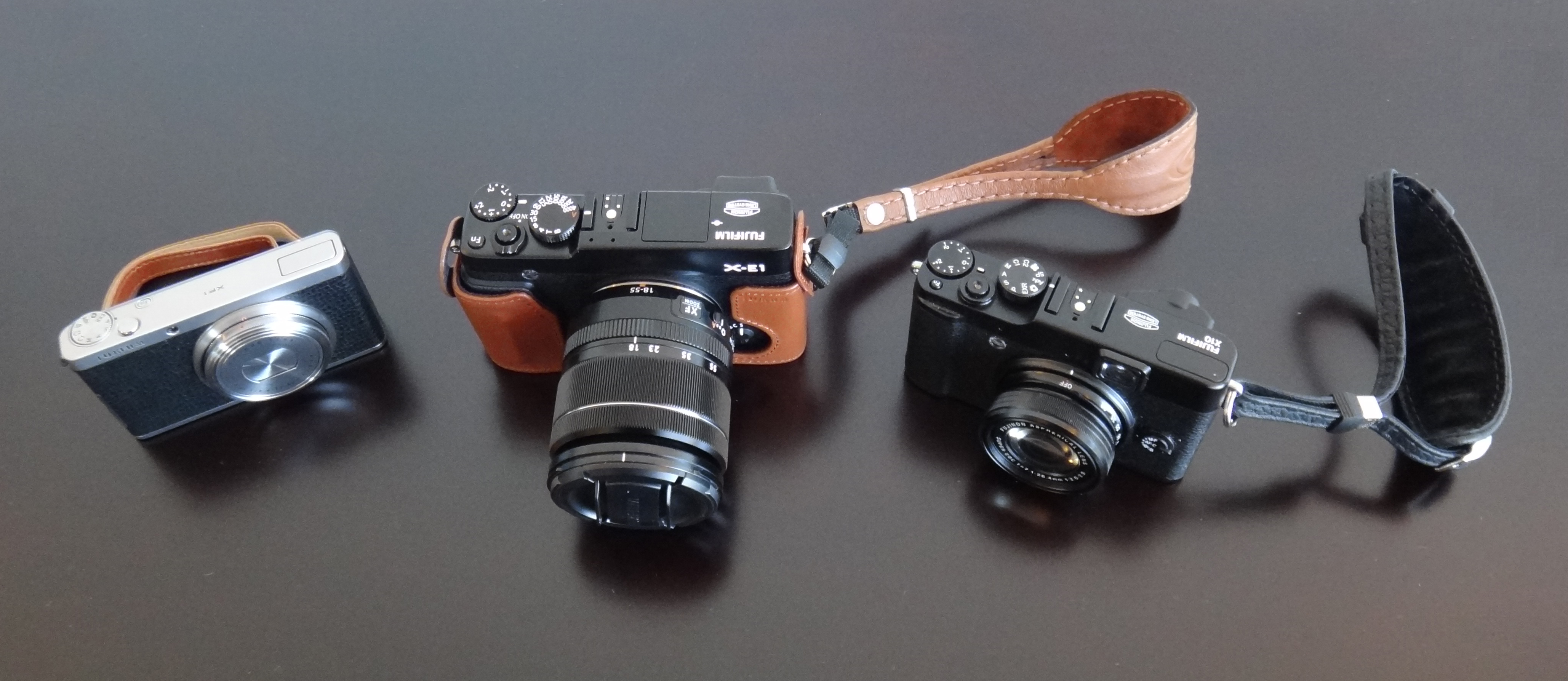|
Fujifilm X100
The Fujifilm X100 is a series of digital compact cameras with a fixed prime lens. Originally part of the FinePix line, then becoming a member of the X series from Fujifilm, the X100 series includes the FinePix X100, X100S, X100T, X100F, and X100V. They each have a large image sensor and a 23 mm lens (35 mm equivalent angle of view in full frame format). All five cameras have received generally positive reviews. The Fujifilm FinePix X100 was initially shown at the photokina show in September 2010 and was subsequently introduced in February 2011. It was the first model in the Fujifilm X-series of cameras and has since been joined by numerous models. It is superseded by the Fujifilm X100S. Fujifilm FinePix X100 The FinePix X100, the original model in the line, was introduced in 2011. This was the first camera in what would grow to become the Fujifilm X series although that designation came later. The X100 is a rangefinder-style camera. Key features * 12.3 MP, APS- ... [...More Info...] [...Related Items...] OR: [Wikipedia] [Google] [Baidu] |
Fujifilm
, trading as Fujifilm, or simply Fuji, is a Japanese multinational conglomerate headquartered in Tokyo, Japan, operating in the realms of photography, optics, office and medical electronics, biotechnology, and chemicals. The offerings from the company that started as a manufacturer of photographic films, which it still produces, include: document solutions, medical imaging and diagnostics equipment, cosmetics, pharmaceutical drugs, regenerative medicine, stem cells, biologics manufacturing, magnetic tape data storage, optical films for flat-panel displays, optical devices, photocopiers and printers, digital cameras, color films, color paper, photofinishing and graphic arts equipment and materials. Fujifilm is part of the Sumitomo Mitsui Financial Group financial conglomerate (''keiretsu''). History 20th century Fuji Photo Film Co., Ltd. was established in 1934 as a subsidiary of Daicel with the aim of producing photographic films. Over the following 10 years, the comp ... [...More Info...] [...Related Items...] OR: [Wikipedia] [Google] [Baidu] |
720p
720p (1280×720 px; also called HD ready, standard HD or just HD) is a progressive HDTV signal format with 720 horizontal lines/1280 columns and an aspect ratio (AR) of 16:9, normally known as widescreen HDTV (1.78:1). All major HDTV broadcasting standards (such as SMPTE 292M) include a 720p format, which has a resolution of 1280×720; however, there are other formats, including HDV Playback and AVCHD for camcorders, that use 720p images with the standard HDTV resolution. The frame rate is standards-dependent, and for conventional broadcasting appears in 50 progressive frames per second in former PAL/SECAM countries (Europe, Australia, others), and 59.94 frames per second in former NTSC countries (North America, Japan, Brazil, others). The number ''720'' stands for the 720 horizontal scan lines of image display resolution (also known as 720 pixels of vertical resolution). The ''p'' stands for progressive scan, i.e. non-interlaced. When broadcast at 60 frames per second, 720p ... [...More Info...] [...Related Items...] OR: [Wikipedia] [Google] [Baidu] |
Digital Photography Review
''Digital Photography Review'', also known as ''DPReview,'' is a website about digital cameras and digital photography, established in November 1998. The website provides comprehensive reviews of digital cameras, lenses and accessories, buying guides, user reviews, and forums for individual cameras, as well as general photography forums. The website also has a database with information about individual digital cameras, lenses, printers and imaging applications. Originally based in London, ''Digital Photography Review'' and most of its team relocated to Seattle, Washington, in 2010. It is currently owned by Amazon. Main features ''DPReview'' has regularly published thorough, technically orientated camera reviews since the website launched in 1998. The content and scope of the reviews have changed over time, but the basic formula (extensive descriptions of controls and menus, consistent, repeatable studio tests, side-by-side pixel-level comparisons) has remained unchanged since ... [...More Info...] [...Related Items...] OR: [Wikipedia] [Google] [Baidu] |
Photokina 2010
Photokina (rendered in the promoters' branding as "photokina") is a trade fair held in Europe for the photographic and imaging industries. It is the world's largest such trade fair. The first Photokina was held in Cologne, Germany, in 1950, and since 1966 it has been held biennially in September at the Koelnmesse Trade Fair and Exhibition Centre in Deutz. The final Photokina under the then-current biennial cycle took place in 2018. Initially, the promoters planned to start a new annual cycle in 2019, with future shows to be held in May, but they later decided not to begin the new annual cycle until 2020. The worldwide outbreak of the Coronavirus disease 2019 and its effect on the imaging industry made Koelnmesse decide to cancel both Photokina 2020 and Photokina 2021. Many photographic and imaging companies introduce and showcase state of the art imaging products at Photokina. Similar trade shows The show has two main competitors, both of which are annual shows held in differe ... [...More Info...] [...Related Items...] OR: [Wikipedia] [Google] [Baidu] |
Image Sensor
An image sensor or imager is a sensor that detects and conveys information used to make an image. It does so by converting the variable attenuation of light waves (as they pass through or reflect off objects) into signals, small bursts of current that convey the information. The waves can be light or other electromagnetic radiation. Image sensors are used in electronic imaging devices of both analog and digital types, which include digital cameras, camera modules, camera phones, optical mouse devices, medical imaging equipment, night vision equipment such as thermal imaging devices, radar, sonar, and others. As technology changes, electronic and digital imaging tends to replace chemical and analog imaging. The two main types of electronic image sensors are the charge-coupled device (CCD) and the active-pixel sensor (CMOS sensor). Both CCD and CMOS sensors are based on metal–oxide–semiconductor (MOS) technology, with CCDs based on MOS capacitors and CMOS sensors based on M ... [...More Info...] [...Related Items...] OR: [Wikipedia] [Google] [Baidu] |
Fujifilm X Series
The Fujifilm X series is a line of digital cameras produced by Fujifilm. The series encompasses fixed lens and interchangeable lens mirrorless cameras and premium compact point-and-shoot cameras aimed at consumer, enthusiast and professional photographers. The X series is part of the larger FinePix range of digital cameras from Fujifilm. The X series models use either APS-C or inch sensors. X series model lines Since its introduction with the X100 in 2011, the X series has grown to encompass a wide variety of designs. These lines can be broken out into the following categories or model lines. APS-C sensor The following lines are united by their use of APS-C-sized sensors measuring 25.1×16.7 mm, with an aspect ratio of 3:2 and Ø31.15 mm field diameter. They are listed here within each category in the order in which the initial model of each type was introduced. Fixed lens * X100 line — These models have a fixed focal length 23mm prime lens and a hybrid ... [...More Info...] [...Related Items...] OR: [Wikipedia] [Google] [Baidu] |
Fujifilm FinePix
The Fujifilm FinePix products are a line of digital cameras produced by Fujifilm. They include compact point and shoot models, tough, waterproof models, bridge digital cameras, digital SLRs and mirrorless cameras. Many use Fujifilm's proprietary Super CCD technology sensors and CMOS sensors for high-end models. Model series ;Current series * F series: Travel Long Zoom, Compact models with exceptional low-light performance and advanced features. * J series: Easy to Use, Low cost, slim, compact series introduced in 2008. * S series: Bridge digital camera ultra-zoom series (including SL Series) with CCD or CMOS sensor. * HS series: Bridge digital camera ultra-zoom series with CMOS sensors, better than S series. * T series: Stylist Zoom, Compact models with powerful zoom. * XP series: Tough, waterproof, shockproof, dustproof and freezeproof series introduced in 2009. * Z series: Slim, Ultra-compact, stylish series introduced in 2005 * Real 3D series: Known also as W Series ... [...More Info...] [...Related Items...] OR: [Wikipedia] [Google] [Baidu] |
Prime Lens
In film and photography, a prime lens is a fixed focal length photographic lens (as opposed to a zoom lens), typically with a maximum aperture from f2.8 to f1.2. The term can also mean the primary lens in a combination lens system. Confusion between these two meanings can occur without clarifying context. Alternate terms, such as ''primary focal length'', ''fixed focal length'', or ''FFL'' are sometimes used to avoid ambiguity. As alternative to zoom lens The term ''prime'' has come to mean the opposite of ''zoom''—a fixed-focal-length, or unifocal lens. While a prime lens of a given focal length is less versatile than a zoom lens, it is often of superior optical quality, wider maximum aperture, lighter weight, and smaller size. These advantages stem from having fewer moving parts, optical elements optimized for one particular focal length, and a less complicated lens formula that creates fewer optical aberration issues. Larger maximum aperture (smaller f-number) facilitate ... [...More Info...] [...Related Items...] OR: [Wikipedia] [Google] [Baidu] |
Bluetooth
Bluetooth is a short-range wireless technology standard that is used for exchanging data between fixed and mobile devices over short distances and building personal area networks (PANs). In the most widely used mode, transmission power is limited to 2.5 milliwatts, giving it a very short range of up to . It employs UHF radio waves in the ISM bands, from 2.402GHz to 2.48GHz. It is mainly used as an alternative to wire connections, to exchange files between nearby portable devices and connect cell phones and music players with wireless headphones. Bluetooth is managed by the Bluetooth Special Interest Group (SIG), which has more than 35,000 member companies in the areas of telecommunication, computing, networking, and consumer electronics. The IEEE standardized Bluetooth as IEEE 802.15.1, but no longer maintains the standard. The Bluetooth SIG oversees development of the specification, manages the qualification program, and protects the trademarks. A manufacturer must meet ... [...More Info...] [...Related Items...] OR: [Wikipedia] [Google] [Baidu] |
USB-C
USB-C (properly known as USB Type-C) is a 24-pin USB connector system with a rotationally symmetrical connector. The designation C refers only to the connector's physical configuration or form factor and should not be confused with the connector's specific capabilities, which are designated by its transfer specifications (such as USB 3.2). A notable feature of the USB-C connector is its ''reversibility''; a plug may be inserted into a receptacle in either orientation. The ''USB Type-C Specification 1.0'' was published by the USB Implementers Forum (USB-IF) and was finalized in August 2014. It was developed at roughly the same time as the USB 3.1 specification. In July 2016, it was adopted by the IEC as "IEC 62680-1-3". A device with a Type-C connector does not necessarily implement USB, USB Power Delivery, or any Alternate Mode: the Type-C connector is common to several technologies while mandating only a few of them. USB 3.2, released in September 2017, replace ... [...More Info...] [...Related Items...] OR: [Wikipedia] [Google] [Baidu] |
WiFi
Wi-Fi () is a family of wireless network protocols, based on the IEEE 802.11 family of standards, which are commonly used for local area networking of devices and Internet access, allowing nearby digital devices to exchange data by radio waves. These are the most widely used computer networks in the world, used globally in home and small office networks to link desktop and laptop computers, tablet computers, smartphones, smart TVs, printers, and smart speakers together and to a wireless router to connect them to the Internet, and in wireless access points in public places like coffee shops, hotels, libraries and airports to provide visitors with Internet access for their mobile devices. ''Wi-Fi'' is a trademark of the non-profit Wi-Fi Alliance, which restricts the use of the term ''Wi-Fi Certified'' to products that successfully complete interoperability certification testing. the Wi-Fi Alliance consisted of more than 800 companies from around the world. over 3.05 billion W ... [...More Info...] [...Related Items...] OR: [Wikipedia] [Google] [Baidu] |





